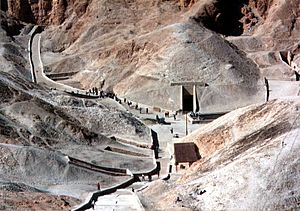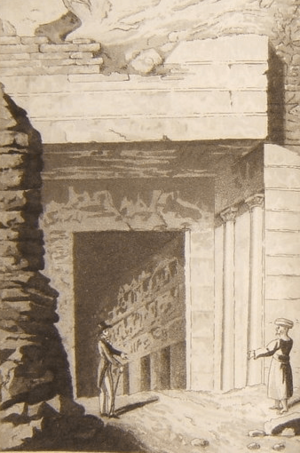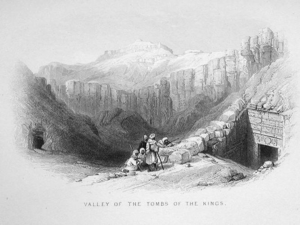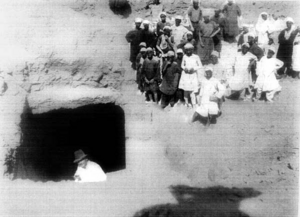Exploration of the Valley of the Kings facts for kids

The Valley of the Kings is a famous place in Luxor, Egypt. For over 200 years, people have been exploring this valley to learn about ancient Egypt. Long ago, even the Romans visited it as tourists!
Studying this area shows how we learn about ancient Egypt. It started with people just looking for old treasures. Now, it's a careful scientific study of the entire Theban Necropolis, which is a huge burial ground. Even with all this work, only eleven tombs have been fully studied and recorded.
Ancient writers like Strabo and Diodorus Siculus wrote about the royal tombs in Thebes. They said there were 47 royal tombs. At that time, only 17 were thought to be still in good condition. Other writers described the tombs as long, pipe-like hallways.
Many tombs have drawings and writings, called graffiti, left by ancient visitors. One researcher, Jules Baillet, found over 2,100 pieces of graffiti. Most of these were in Greek and Latin. You can find most of this ancient graffiti in tomb KV9. The oldest graffiti found dates back to 278 BC.
Contents
Exploring the Valley: The 1700s
Before the 1800s, traveling to Thebes was very hard. It took a long time and cost a lot of money. Only a few brave European travelers made the trip. For a while, people weren't even sure where Thebes was! They knew it was on the Nile River, but sometimes they mixed it up with other cities.
One of the first people to write about what he saw in Thebes was Frederic Louis Norden. He was an adventurer and artist from Denmark. After him, Richard Pococke created the first modern map of the Valley of the Kings in 1743.
Napoleon's Expedition
In 1799, Napoleon's team came to Egypt. Dominique Vivant and others drew maps and plans of the known tombs. They also found the Western Valley for the first time. There, Prosper Jollois and Édouard de Villiers du Terrage located the tomb of Amenhotep III (called WV22). The Description de l'Égypte is a huge book series about Egypt. Two of its 24 volumes are about the area around Thebes.
Exploring the Valley: The 1800s

European explorers kept coming to Thebes in the 1800s. This was helped by Champollion figuring out how to read hieroglyphs. Early in the century, Giovanni Battista Belzoni worked for Henry Salt. Belzoni found several tombs. These included the tomb of Ay in the West Valley (WV23) in 1816. He also found the tomb of Seti I (KV17) the next year. After his discoveries, Belzoni thought all the tombs had been found. He believed there was nothing left to discover. At the same time, Bernardino Drovetti was also exploring. He was a French official and a big rival of Belzoni.
In 1827, John Gardiner Wilkinson was asked to draw the entrance of every tomb. He gave each tomb a number that we still use today. They were numbered from KV1 to KV21. "KV" stands for King's Valley. His maps showed 28 entrances, but some were not explored yet. Wilkinson's drawings and maps were published in 1830. Around the same time, James Burton explored the valley. He made tomb KV17 safer from floods. He is also known for entering KV5.
Champollion himself visited the valley in 1829 with Ippolito Rosellini and Nestor L'Hôte. This trip was called the Franco-Tuscan Expedition. They spent two months studying about 16 open tombs. They copied the writings and figured out who was buried in each tomb. From tomb KV17, they took some wall decorations. These are now in the Louvre museum in Paris.
From 1845 to 1846, Karl Richard Lepsius led an expedition. They explored and wrote about 25 tombs in the main valley. They also looked at four tombs in the west.
Later in the 1800s, people started trying to save ancient items, not just collect them. Auguste Mariette's Egyptian Antiquities Service began exploring the valley. First, Eugène Lefébure worked there in 1883. Then, Jules Baillet and Georges Bénédite explored in 1888. Finally, Victor Loret worked from 1898 to 1899. Loret added 16 more tombs to the list. He also explored several tombs that had already been found. During this time, Georges Daressy explored KV9.
When Gaston Maspero became the head of the Egyptian Antiquities Service again, exploration changed. Maspero made Howard Carter the Chief Inspector of Upper Egypt. Carter was young and found several new tombs. He also explored others, like KV42 and KV20.
Exploring the Valley: The 1900s
Around the early 1900s, an American named Theodore M. Davis had the permission to dig in the valley. His team, mostly led by Edward R. Ayrton, found several royal and non-royal tombs. These included KV43, KV46, and KV57. In 1907, they found a possible hidden collection of items from the Amarna Period in KV55.
After finding what they thought was all that was left of Tutankhamun's burial (items from KV54 and KV58), Davis announced that the valley was fully explored. He believed no more burials would be found. In his 1912 book, he wrote, "I fear that the Valley of Kings is now exhausted."
After Davis died in 1915, Lord Carnarvon got the permission to dig. He hired Carter to explore the valley. After a careful search, they discovered the actual tomb of Tutankhamun (KV62) in November 1922. This was a huge discovery!
At the end of the 1900s, the Theban Mapping Project found and explored tomb KV5 again. This tomb is now thought to be the largest in the valley. It has at least 120 rooms! It was the burial place for the sons of Ramesses II. Other teams also cleaned and studied tombs in the eastern and western parts of the valley. Until 2002, the Amarna Royal Tombs Project explored the area around KV55 and KV62. These are tombs from the Amarna Period in the main valley.
Exploring the Valley: The 2000s
Many teams have continued to explore the valley, learning much more about the area. In 2001, the Theban Mapping Project put up new signs for the tombs. These signs give information and maps of the tombs that are open to visitors.
On February 8, 2006, the Supreme Council of Antiquities announced a big find. An American team from the University of Memphis had found a new tomb from the pharaohs' time. It was called KV63. This was the first new tomb found since King Tutankhamun's in 1922! This tomb from the 18th Dynasty had five sarcophagi (stone coffins) with colorful masks. It also had 28 large storage jars with pharaohs' seals. It is located close to Tutankhamun's tomb.
KV63 seems to be one room with seven sarcophagi and about 20 large jars. It's from the 18th Dynasty. It looks like it was a place to store materials used for preparing bodies for burial, rather than a tomb itself. So far, no mummies have been found in the sarcophagi. It is now thought of as a mummification chamber.
On July 31, 2006, Nicholas Reeves said that special radar scans from 2000 showed something hidden underground. It was near KV62 and KV63. He called this hidden spot "KV64." This caused some discussion. Only Egypt's Supreme Council of Antiquities can officially name a new tomb. Also, the hidden spot might not even be a tomb. Reeves told the news first, instead of writing a scientific paper.
In May 2008, Zahi Hawass announced that an Egyptian team was looking for the tomb of Ramesses VIII. They were focusing near the tombs of Merenptah and Ramesses II. In August 2008, two more tomb entrances were found. These were planned to be explored in October 2008. At the same time, work began to clear the long tunnel in KV17.




